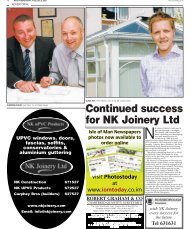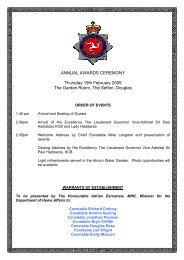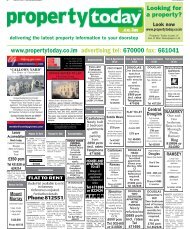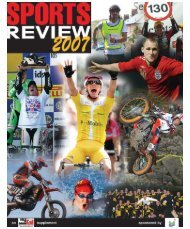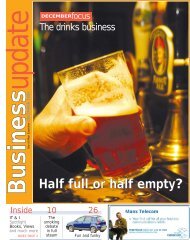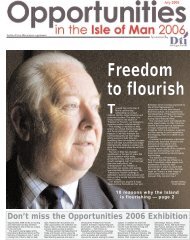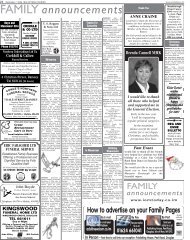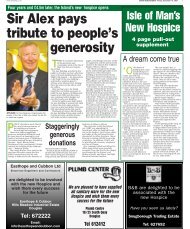m - Isle of Man Today
m - Isle of Man Today
m - Isle of Man Today
You also want an ePaper? Increase the reach of your titles
YUMPU automatically turns print PDFs into web optimized ePapers that Google loves.
6<br />
m<br />
anxmillennium<br />
m<br />
anxmillennium<br />
19<br />
Ihave not seen many photographs <strong>of</strong><br />
men down mines but this view shows<br />
Le Neve Forster, Chief Inspector <strong>of</strong><br />
Mines. The label on the lantern slide says<br />
the view was taken down Foxdale Mines.<br />
Notice the thickness <strong>of</strong> timbers used as pit<br />
props and the constant presence <strong>of</strong> water<br />
under foot. Notice also the candle held on the<br />
hat by a lump <strong>of</strong> clay. Perhaps there is a<br />
reader who can advise about the pipe<br />
system above his head. MNH/pic/4346<br />
Another views <strong>of</strong> Tynwald<br />
fair but one taken from a<br />
photographic print. The<br />
original photograph is believed<br />
to have been taken by Sophia<br />
Morrison about 1910. Sophia<br />
was the author <strong>of</strong> the little book<br />
‘<strong>Man</strong>x Fairytales’. Notice how<br />
the centre house was at that<br />
time the place for teas and<br />
c<strong>of</strong>fees. The ladies in the<br />
foreground are standing on the<br />
raised ground around the base<br />
<strong>of</strong> Tynwald Hill.<br />
Photo No 2<br />
Apostman by a postbox is the subject <strong>of</strong> this glass negative<br />
held in the museum library as part <strong>of</strong> the Southward<br />
collection. The title on the negative is ‘P.M. Corlett<br />
postman at letterbox opposite our gate’ Philip Murray Corlett<br />
was a son <strong>of</strong> Philip Corlett, Sadler and Harness maker. P.M.<br />
also worked as a sadler as well as being a postman. His<br />
brother John was a miller and brother Thomas Edward was a<br />
coach builder. The family shop existed next to the Ramsey<br />
Town Hall for many years and ledgers showed how some work<br />
was done on a barter basis being paid for over a period with<br />
farm produce. Skins were imported from England as well as<br />
purchased locally. Pony hide was bought as well as cowhide and<br />
dog skin was used to make waterpro<strong>of</strong> tobacco pouches. The<br />
first pillar box to be erected in the <strong>Isle</strong> <strong>of</strong> <strong>Man</strong> in December 1858<br />
was opposite Albert Terrace at the junction with Osborne<br />
Terrace in Douglas. The second box was a wall box placed in<br />
Sandy Road, Ramsey, (later renamed Bowring Road in February<br />
1859.) This could very well be that box <strong>of</strong> 1859. The photograph was<br />
taken by Mr Southward who was a distant relation to the Corletts.<br />
Southward Box 1 No 11<br />
An interesting child portrait but<br />
no name for the photographer.<br />
The young lad is John F.<br />
Crellin, son <strong>of</strong> J. C. Crellin MHK <strong>of</strong><br />
Ballachurry, Andreas. The boy is<br />
dressed in an especially made uniform<br />
<strong>of</strong> the <strong>Man</strong>x Fencibles. The first corps <strong>of</strong><br />
<strong>Man</strong>x Fencibles was raised in 1779 and<br />
subsequent Corps in 1793, 1795 and 1803.<br />
The picture dates from considerably<br />
later. MNH/pic/4342<br />
Afamiliar sight for northern residents is the former<br />
town hall at Ramsey which was demolished in 1972,<br />
following an outbreak <strong>of</strong> dry rot. Now its replacement<br />
lego building is to be demolished and replaced by a pseudo<br />
Victorian building but few modern buildings that try to<br />
look old can achieve the same ‘presence’ as the real thing.<br />
Look carefully at this building which, with the exception <strong>of</strong><br />
the semi-dormer windows, is not balanced either side <strong>of</strong> the<br />
central doorway. One side has a projecting oriel bay<br />
window at first floor level, the other includes a fire station<br />
which housed a horse drawn fire engine. When the fire<br />
engine was changed the arched brickwork above the door<br />
was removed and replaced by a straight lintel at a higher<br />
level so that the new engine could get in. The town hall design<br />
was the subject <strong>of</strong> an architectural competition which was won<br />
by a Mr Berrington who received the £10 prize. This was in May<br />
1888 and by August 1889 the building was handed over to the<br />
commissioners. On the first floor windows behind the<br />
decorative street lamp can be read the words ‘school<br />
committee’ The clock which fitted the circle in the central<br />
pediment was added in 1911. Southward Box 2 No 15



